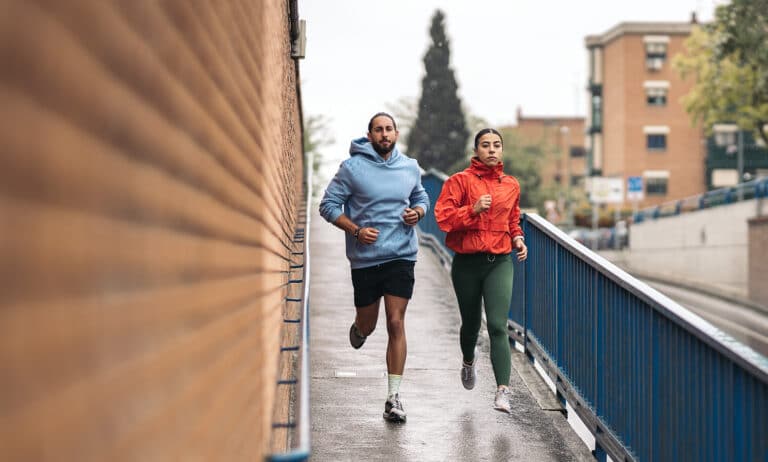


“The hip bone is connected to the Thigh Bone”, as to quote a line from a very familiar song is very applicable to the treatment and rehabilitation of running injuries.
The kinetic chain is the mechanical system by which runners or athletes accomplish functional tasks in their sport. Any weakness along this chain can lead to injury further down the chain and if not addressed the injury can return even if the local lesion is treated.
In practical terms a knee problem can be traced to a muscular imbalance in control of the pelvis, hip, gluteals or hamstrings. Foot injuries can result from inactive lateral gluteal muscles thus rendering over pronation of the foot on landing.

Some common running injuries that result from a break down in the kinetic chain of the lower limb:
‘Runners Knee’ typically presents as a dull, aching pain around or behind the kneecap (patella) where it connects with the lower end of the thighbone (femur). This pain may be felt when you’re in action – running, squatting, climbing stairs, or even after prolonged periods of sitting. It may also be accompanied by a sensation of grinding or clicking within the knee. It’s crucial to remember that these symptoms can be indicative of a disturbance in the kinetic chain, and addressing the underlying issues can significantly aid in recovery.
‘Runners Knee’ is a result of tightness of the ITB, causing friction over the lateral condyle of the femur as a result of inactive gluteal muscles laterally or poor tracking of the knee cap.
A hamstring strain often feels as a sudden sharp pain in the back of the thigh, which can be severe. This pain is typically felt during exercise, often when running or jumping. Following the initial injury, the area can be tender to touch, with swelling and bruising possibly appearing. As time progresses, discomfort may continue to be felt when walking or bending over, and there might be a noticeable weakness in the leg.
Recurrent hamstring strains may be due to inactive gluteal muscles causing the hamstrings to recurrently overfire. The injury cannot be resolved solely through stretching; it is imperative to strengthen the gluteal muscles to facilitate healing.
Plantar Fasciitis typically presents as a sharp, stabbing pain or deep ache in the bottom of the foot near the heel. The pain is usually worst with the first few steps after awakening, although it can also be triggered by long periods of standing or rising from sitting. The pain is further worsened after exercise, not during it.
Plantar Fasciitis can occur due to tight and shortened calf and Achilles, loading the underneath of the foot. Stiff toe joints can also load the fascia as the natural push off phase is restricted.
Sciatic pain is typically characterised by a sharp, jolting pain that begins in the lower back or buttocks, and shoots down one, or occasionally both, legs. The pain might be intermittent or constant, and its intensity can vary from mild to severe. It is often likened to electric shocks, and may be accompanied by a burning sensation, numbness, or tingling that extends down the leg. The discomfort may intensify with sudden movements, such as coughing or sneezing, and prolonged sitting can also exacerbate the symptoms.
Sciatic pain caused by running often stems from stiffness in the facet joints, back muscles, and piriformis on one side of the body. This stiffness typically arises due to overuse on one side when the deep postural muscles fail to activate properly on the opposite side.
For every running injury, it is crucial to conduct a comprehensive assessment of the entire kinetic chain to identify the underlying cause of the problem. This will reduce the frustration in runners who regularly just receive local treatment for the injury, only for it to recur on returning to running.
Schedule your kinetic chain review with Wendy Davis Physiotherapy today to enhance your running technique and reduce the risk of injuries.
Share this article
Do you ever experience tight or stiff muscles after your runs? Or do you encounter...
What is Pilates? While there are many different styles of Pilates, fundamentally, it is all...
Hip injuries in runners are often a result of intrinsic and extrinsic factors that challenge...
Completing a marathon is a huge accomplishment. After months of training and hard work, crossing...
By yoga teacher, Anneke West. Running is a popular, easy and a fantastic way to...
Running undoubtedly stands as a fantastic approach to achieving your fitness goals. It draws millions...
We’re here to make sure you’re up-to-date with the latest running tips, events and product discounts – we’ve always got your back! Rest assured, we value your privacy and would never dream of selling your address.
BONUS: Sign up today and receive a FREE code for our Sub-4-Hour Marathon Plan